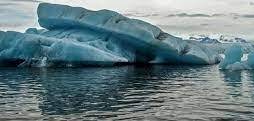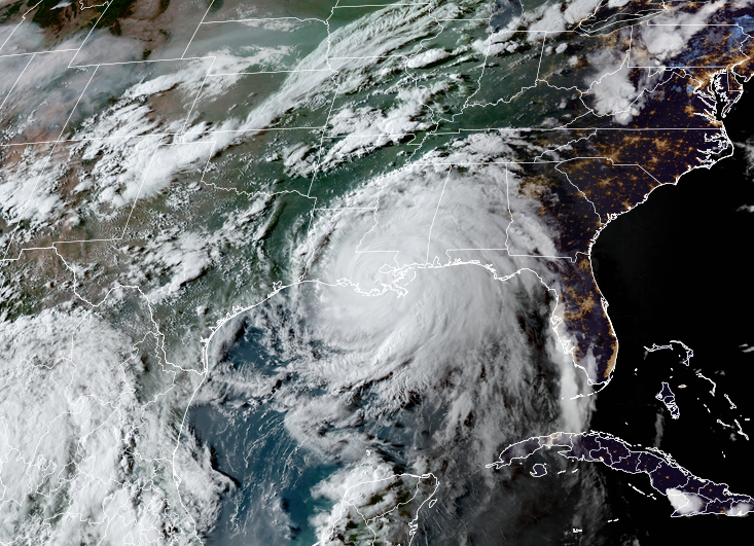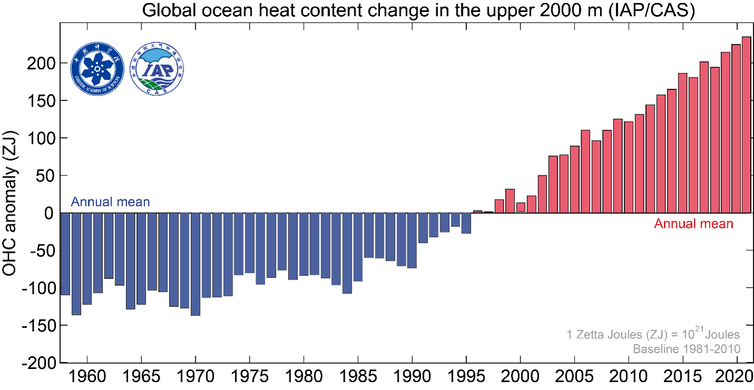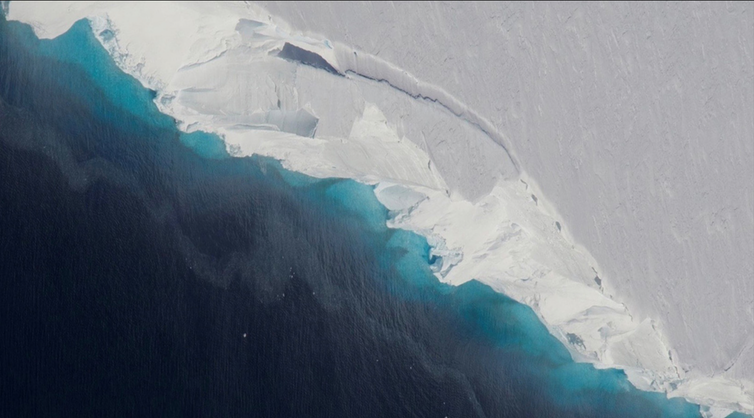
The world has witnessed climate disasters and weather record in 2021, ranging from the destructive flash floods that swept the cities mountain in Europe and flooded the subway systems in China and the States , heat waves and forest fires. The typhoon Rai has killed more than 400 people in the Philippines; Hurricane Ida caused damage estimated at 74 billion dollars in the United States.
Globally, it was the sixth warmest year on record for surface temperatures, according to data released by NASA and the National Oceanic and Atmospheric Administration in their annual report on the global climate the 13 January 2022. But under the surface, the ocean temperatures have set new heat records in 2021.
As explained climatologist Kevin Trenberth , while the surface temperature of the Earth is what people live from day to day, the temperature in the upper part of the ocean is a better indicator how excess heat builds up on the planet.
The Conversation spoke with Trenberth, co-author of a study published January 11, 2022 by 23 researchers from 14 institutes followed the warming of the oceans of the world.

Hurricane Ida caused $ 74 billion in damage from Louisiana to the northeastern United States in 2021.
Your latest research shows ocean heat is at record highs. What does that tell us about global warming?
The world's oceans are warmer than ever on record, and their heat has increased every decade since the 1960s. This relentless increase is a primary indicator of human-induced climate change. Have
As the oceans warm, their heat overload weather systems, creating storms and stronger hurricanes and more intense precipitation. This threatens the lives and livelihoods as well as marine life. Have
Oceans absorb about 9.3% extra energy trapped by rising gas greenhouse from human activities, especially the burning of fossil fuels. Because water retains more heat than land and the volumes involved are immense, the upper oceans are a primary memory of global warming. I explain this in more detail in my new book " The Changing Flow of Energy Through the Climate System ."

Heat content of the oceans in the top 2000 meters of the world's oceans since 1958, compared to the 1981-2010 average. The units are zettajoules. Lijing Cheng
Our study provided the first analysis of ocean warming in 2021 , and we could attribute the warming to human activities. Global warming is alive and well, unfortunately. Have
The global average surface temperature was the fifth or sixthwarmest on record in 2021 (the record depends on the data set used), partly due to the conditions la niña throughout the year, where the cool conditions in the tropical Pacific influence weather worldwide.
There are many more natural variability in surface air temperatures in the ocean temperatures due to El Niño / La Niña and weather events. This natural variability over a warming ocean creates hot spots, sometimes referred to as “marine heat waves,” which vary from year to year. These hot spots have profound influences on marine life, from tiny plankton to fish, to marine mammals and birds. Other hot spots are responsible for more activity in the atmosphere, such as hurricanes.
While surface temperatures are both a consequence and a cause, the main source of phenomena causing extremes is related to the heat of the oceans which energizes weather systems.

Scientists are concerned about the stability of the Thwaites Glacier in Antarctica, which holds large amounts of land ice. NASA
We have found that all oceans are warming, with the greatest amounts of warming in the Atlantic Ocean and the Southern Ocean surrounding Antarctica. This is a concern for the Antarctic ice - heat in the Southern Ocean can slide under the ice platforms in the Antarctic , the clearing and causing huge icebergs calving. Ocean warming is also a concern for raising the level of the sea.
In what ways does extra ocean heat affect air temperature and moisture on land?
Global warming increases evaporation and drying out on earth, as well as rising temperatures, increasing the risk of heat waves and forest fires. We have seen the impact in 2021, particularly in western North America , but also in the middle of the heat waves in Russia, Greece, Italy and Turkey.
The oceans also provide warmer atmospheric rivers of moisture for land areas, increasing the risk of flooding, as the west coast of the United States was known.
2021 saw several destructive hurricanes, including Hurricane Ida in the United States and the Philippines typhoon Rai. How does ocean temperature affect storms like these?
Warmer oceans provide additional moisture to the atmosphere. This additional moisture feeds the storms, especially hurricanes. The result can be prodigious rainfall, such as the United States have seen since Ida, and widespread flooding as occurred in many places over the past year. Have
Storms can also become more intense, larger, and last longer. Several major floods occurred in Australia last year, as well as in New Zealand. Larger snowfall can also occur in winter provided that the temperatures remain below the freezing point since the warmer air holds more moisture.
If the greenhouse gas emissions slowed, would the ocean cool down?
In the oceans, warm water is found above cooler, denser waters. However, the oceans are getting warmer from top to bottom, and as a result, the ocean is becoming more and more layered. This inhibits the mixing between the layers which would otherwise allow the ocean to warm to deeper levels and to absorb carbon dioxide and oxygen. Hence, it has an impact on all marine life. Have
We found that the first 500 meters of the ocean is clearly warming since 1980; depths of 500 to 1,000 meters have been warming since about 1990; depths of 1,000 to 1,500 meters since 1998; and below 1,500 meters since about 2005.
The slow penetration of heat downwards means the oceans will continue to warm and sea levels will continue to rise even after greenhouse gases stabilize.
The final area that needs attention is the need to increase the capacity of scientists to monitor changes in the oceans. To do this, we use the Argo array- currently about 3,900 profiling floats that return data on the temperature and salinity of the surface to about 2000 meters depth, when measured back then down, in ocean basins around the world. These robotic, diving and drift instruments require constant replenishment and their observations are invaluable. Have
Sources
 Kevin Trenberth - Eminent Researcher, NCAR; Affiliated Faculty, University of Auckland
Kevin Trenberth - Eminent Researcher, NCAR; Affiliated Faculty, University of Auckland
- The Conservation
Posted on 2022-01-14 15:48








Comments